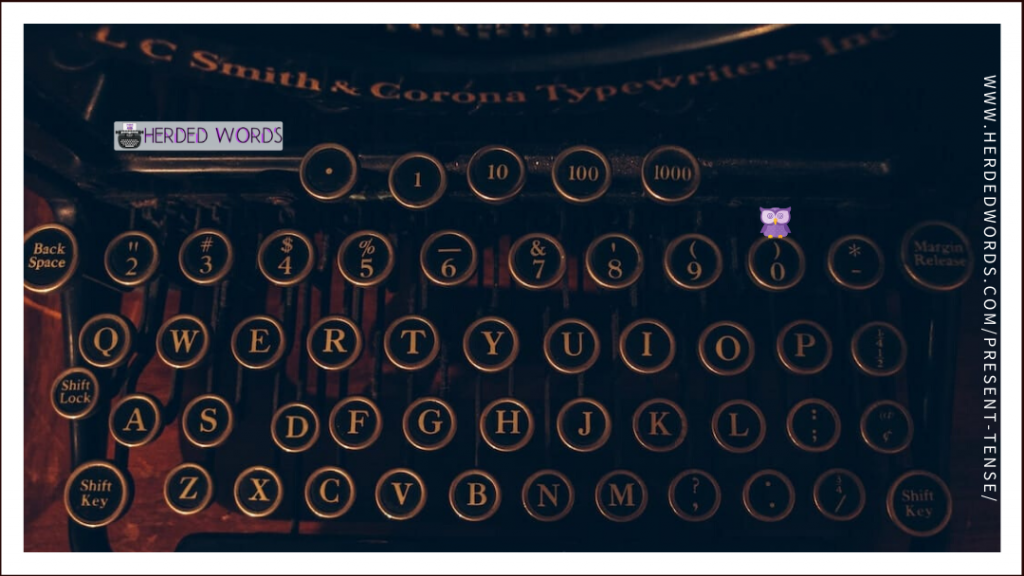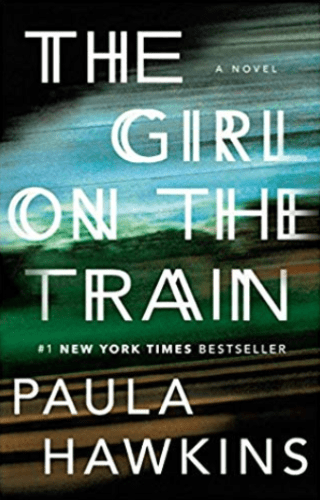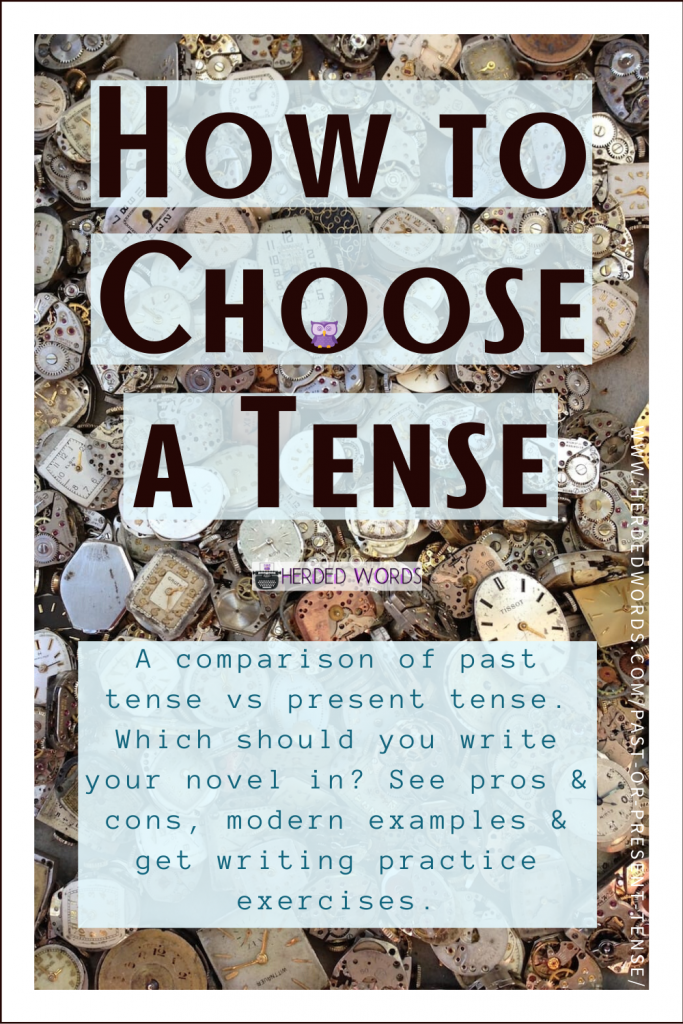
Herdedwords.com uses affiliate links. This means we receive a commission on the sale of certain items. This is at NO additional cost to you. Visit the policies page to learn more.
Present tense has been rising in popularity over recent decades.
In novels, the present tense is often considered riskier, more contemporary, edgier, etc. Its usage is increasing a lot in genres like Young Adult, Contemporary and Memoirs.
One of the first decisions to make about a story is what tense will it be written in – past tense or present tense?
Let’s take a dive into the Present Tense!
Table of Contents
Verb Tense Definitions & Explanations
Verbs! Verbs! Verbs! What is a verb?
Verbs are used to describe actions, occurrences or states of being. There are 3 tenses – Past, Present & Future.
| PAST tense | PRESENT tense | FUTURE tense | |
| ACTION | He SMILED at her. | He SMILES at her. | He WILL SMILE at her. |
| OCCURRENCE | They BECAME doctors. | They ARE BECOMING doctors. | They WILL BECOME doctors. |
| STATE OF BEING | She WAS excited. | She IS excited. | She WILL BE excited. |
The 4 Present Tenses
Oh, Grammar! How I love and hate thee.
We already dove into the Past Tense and I hope you remember the four tenses – simple, progressive, perfect & perfect progressive – because the present tense uses the same ones.
| Explain, Please. | Example | |
| SIMPLE | The simple present tense shows action or states that happen in the present.It is NOT used to show actions that are happening right now. | Jane wants to be a writer. |
| PROGRESSIVE | The present progressive tense describes something that is in progress in the present. | She is always writing in her journal. |
| PERFECT | The present perfect tense describes something that was completed before the present. | Jane has begun to write her first novel. |
| PERFECT PROGRESSIVE | The present perfect progressive tense describes something that was started in the past and continued until the present. | She has been writing the novel for the last 2 months. |
Write a Story in Present Tense to…
#1 – Feel More Cinematic
Present tense can feel very cinematic – you’re following along with the character in ‘real-time.’ Of course, it’s not actually real-time, but the sensation is like watching TV or a movie.
Adding to the cinematic feel – descriptions are given as what it is instead of what it was. This makes it easy to visualize.
Example: THE GIRL ON THE TRAIN
THE GIRL ON THE TRAIN, published in 2015, is a mystery, thriller & suspense novel by Paula Hawkins. The movie was released in 2016.
THE GIRL ON THE TRAIN spent 26 weeks at #1 on the NYT bestseller list. It had sold an estimated 15 million copies worldwide by October 2016.
THE GIRL ON THE TRAIN is a very visual novel. It’s very descriptive. Most of the novel happens in a small number of settings. These things both add to the cinematic feeling the novel presents.
THERE IS A PILE OF clothing on the side of the train tracks. Light-blue cloth – a shirt, perhaps – jumbled up with something dirty white.
Example: ALL THE LIGHT WE CANNOT SEE
ALL THE LIGHT WE CANNOT SEE, published in 2014, is a historical fiction novel by Anthony Doerr.
ALL THE LIGHT WE CANNOT SEE won the 2015 Pulitzer Prize for Fiction. It also spent 1 week at #1 on the NYT Bestseller List.
ALL THE LIGHT WE CANNOT SEE is a historical novel written in the present tense. It’s a rare feeling to feel as if you’re part of history but the novel succeeds at giving you that feeling.
Rarely do I read a book and truly visualize it, but that’s exactly what I did with ALL THE LIGHT WE CANNOT SEE. The whole time I was reading, I saw soft-lit visions of the scenes.
At six forty she collects her white cane from the corner, loops a finger through the back of her father’s belt, and follows him down three flights and up six blocks to the museum.
#2 – Deliberately Mislead the Reader
Present tense (usually combined with 1st person POV) is the best way to mislead your reader. This situation is often referred to as an unreliable narrator.
An unreliable narrator is one who doesn’t tell the whole/correct story – they leave out details, misrepresent things, outright lie. This could be deliberate on their part (the narrator), or not. But it should definitely be deliberate on your part (the writer).
Example: LESS
LESS, published in 2017, is a satirical comedy novel by Andrew Sean Greer.
LESS won the 2018 Pulitzer Prize for Fiction.
LESS is misleading primarily because the reader doesn’t find out who the narrator is until the end. Are they trustworthy? Maybe, maybe not.
Personally, I felt like Arthur Less was narrating his own story as one of those people who refer to themselves in the third person. He wasn’t and I always found it a bit unpleasant when the novel made reference to the narrator.
Arthur Less is the first homosexual ever to grow old. That is, at least, how he feels at times like these.
#3 – Make Everything Feel Immediate
Present tense provides a feeling of immediacy because everything is happening in real-time. As in, right now!
Because the story isn’t over (like with past tense) anything can still happen. This can help keep your readers turning pages to find out what’s happening.
Example: GONE GIRL
GONE GIRL, published in 2012, is a mystery, thriller & suspense novel by Gillian Flynn. The movie was released in 2014.
GONE GIRL spent 8 weeks at #1 on the NYT Bestseller List. It’s estimated the novel sold more than 15 million copies worldwide by 2016.
Amy is missing (presumed murdered) and Nick is a suspect – she needs to be found NOW!
The real immediate feel of GONE GIRL, using the present tense, doesn’t start until the second half of the book. Once you learn what really happened.
Pay attention, because this is impressive. It started with my vacant-brained friend Noelle.
*Nick’s chapters of the book are written in the past tense!
Example: THE STONE SKY
THE STONE SKY, published in 2017, is a science fantasy novel by N. K. Jemisin. It’s book 3 in the Broken Earth trilogy.
THE STONE SKY won the 2018 Hugo Award. All three books in the trilogy won Hugo Awards.
The whole premise of THE STONE SKY is based on the world ending. If that’s not of immediate concern, what is?
THE STONE SKY succeeds at making the reader feel they have to keep turning the pages. Will they save the world?
This is rank hypocrisy. The decision Nassun has recently made, a silent promise over her father’s corpse, belies it. Schaffa cannot know what she has chosen, but at the corner of her vision, she is painfully aware of Steel’s lingering, blood-painted smile.
#4 – Use First Person Point of View
First person can be used with the past or present tense. But, first person and present tense are more commonly used together.
Example: SING, UNBURIED, SING
SING, UNBURIED, SING, published in 2017, is a fiction novel by Jesmyn Ward.
SING, UNBURIED, SING won the 2017 National Book Award for Fiction.
SING, UNBURIED, SING combines the present tense with a first person point of view.
Pop wrestles the goat like it’s a man, and the goat’s knees buckle.
#5 – Simplify Tense Usage
There are a total of 12 tenses in English – 4 past, 4 present and 4 future.
When you write a novel in the ‘past tense’ you will usually use most (if not all) of the 12 tenses. Yes, you’ll stick mostly with simple past but other tenses will make regular appearances.
This is not the case with present tense novels. Present tense novels may only use the simple present! At most, they tend to use 4 of the tenses – the simple present, the present progressive and small amounts of the simple past and the simple future.
Example: FIFTY SHADES OF GREY
FIFTY SHADES OF GREY, published in 2011, is a romance novel by E. L. James. It’s book 1 in the Fifty Shades trilogy.
FIFTY SHADES OF GREY spent 29 weeks at #1 on the NYT bestseller list. By June 2015 it had sold over 125 million copies worldwide. The movie was released in 2015.
FIFTY SHADES OF GREY is told in the present tense in the first person (via Ana).
It’s a straightforward novel with a simple writing style. This makes the readers focus more on the story (Ana and Grey) and less on the writing.
I sit down, fish the questions from my satchel, and go through them, inwardly cursing Kate for not providing me with a brief biography.

Writing Practice
Fairytales are written in the past tense. Today, we’ll be rewriting sections of LITTLE RED RIDING HOOD into the present tense.
We’ll be using the version LITTLE RED-CAP written by the Brothers Grimm. If you’re not familiar with the story, take 5 minutes and read it.
If you already did the exercises from Writing a Story in the Past Tense you might think you’re already half done this week’s exercises, but you’d be wrong. Don’t just change your past tense exercises into present tense – WRITE NEW ONES!
Exercise: From Past Tense to Present Tense
The excerpt below is 34 words.
Your Task: Rewrite the excerpt in the present tense. Make it a minimum of 70 words. Add some creative flair to make it your own.
LITTLE RED-CAP Excerpt
The wolf thought to himself: ‘What a tender young creature! what a nice plump mouthful—she will be better to eat than the old woman. I must act craftily, so as to catch both.’
Need an idea?
The excerpt can be extended in any way you want, but if you’re struggling to think of something try this:
Describe how/why the wolf sees Red as a ‘tender young creature,’ instead of just having him think it.
- What makes Red attractive to the wolf?
- Is it because she’s young?
- Does she have a delicious scent?
- Does the wolf need both because it’s been a long time since he last ate?
The wolf watches Red with great interest. ______________________. He thinks to himself: ‘What a tender young creature! what a nice plump mouthful—she will be better to eat than the old woman. I must act craftily, so as to catch both.’
Exercise: From Past Tense to Present Tense
The excerpt below is 43 words.
Your Task: Rewrite the excerpt in the present tense. Make it a minimum of 200 words. Be creative and make the excerpt your own!
Bonus Challenge: Try not to write any dialogue.
LITTLE RED-CAP Excerpt
The wolf lifted the latch, the door sprang open, and without saying a word he went straight to the grandmother’s bed, and devoured her. Then he put on her clothes, dressed himself in her cap laid himself in bed and drew the curtains.
Need an idea?
The excerpt can be extended in any way you want, but if you’re struggling to think of something try this:
Leave everything except the 3 words “and devoured her.” Extend it by writing a scene of the wolf devouring the grandmother:
- Does the grandmother struggle?
- Do things break?
- Is the scene gruesome and bloody or is the wolf quiet and cunning?
The wolf lifts the latch, the door springs open, and without saying a word he goes straight to the grandmother’s bed and devoured her. _______________________. Then he puts on her clothes, dresses himself in her cap lays himself in bed and draws the curtains.
Words, Not Ideas

From 43 words to …?
Even if 1,000 people wrote the same ‘idea,’ we would still wind up with 1,000 different versions of the story.
It’s rare to find a story idea that hasn’t been done before – it’s the way you use your words that will make your story special.
Share your exercises in the comments!
Now that you have a handle on the tenses individually (past and present), you might want to check out Past Tense vs Present Tense next.
Like this post? Please PIN IT and follow me on social media. Thanks!















